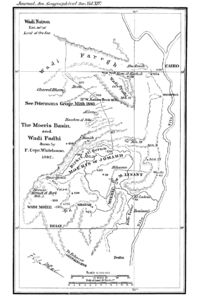- Lake Moeris
-
Lake Moeris (Ancient Greek: Μοἵρις, genitive Μοίριδος) is an ancient lake in the northwest of the Faiyum Oasis, 80 km (50 mi) southwest of Cairo, Egypt. It persists in modern times as a smaller lake called Birket Qarun. The lake's surface is 140 ft (43 m) below sea-level, and covers about 78 square miles (200 km2).
Lake Moeris was freshwater in prehistory, but is today a saltwater lake. It is a source for tilapia and other fish from the local area. Its area is estimated to vary between 490 mi² (1,270 km²) and 656 mi² (1,700 km²).
Moeritherium was found in this area.
Contents
History
When the Mediterranean Sea was a hot dry hollow near the end of the Messinian Salinity Crisis in the late Miocene, Faiyum was a dry hollow, and the Nile flowed past it at the bottom of a canyon (2400 m deep or more where Cairo is now). After the Mediterranean reflooded at the end of the Miocene, the Nile canyon became an arm of the sea reaching inland further than Aswan. Over geological time that sea arm gradually filled with silt and became the Nile valley.
Eventually, the Nile valley bed silted up high enough to let the Nile in flood overflow into the Faiyum hollow and make a lake in it. The lake is first recorded from about 3000 BC, around the time of Menes (Narmer). However, for the most part it would only be filled with high flood waters. The lake was bordered by neolithic settlements, and the town of Crocodilopolis grew up on the south where the higher ground created a ridge.
In 2300 BC, the waterway from the Nile to the natural lake was widened and deepened to make a canal which is now known as the Bahr Yussef. This canal fed into the lake. This was meant to serve three purposes: control the flooding of the Nile, regulate the water level of the Nile during dry seasons, and serve the surrounding area with irrigation. There is evidence of ancient Egyptian pharaohs of the twelfth dynasty using the natural lake of Faiyum as a reservoir to store surpluses of water for use during the dry periods.
The immense waterworks undertaken by the ancient Egyptian pharaohs of the twelfth dynasty to transform the lake into a huge water reservoir gave the impression that the lake was an artificial excavation, as reported by classic geographers and travellers [1]. The lake was eventually abandoned due to the nearest branch of the Nile shrinking from 230 BC.
Etymology

![G36 [wr] wr](/w/extensions/wikihiero/img/hiero_G36.png)
![N35 [n] n](/w/extensions/wikihiero/img/hiero_N35.png)
![N35 [n] n](/w/extensions/wikihiero/img/hiero_N35.png)
![N35 [n] n](/w/extensions/wikihiero/img/hiero_N35.png)
mer-wer (Moeris)
in hieroglyphsThe name "Moeris" is a Greek adaptation of ancient Egyptian Mer-Wer (= "The Great Lake").[2] In ancient Egypt, the lake was also variously called "the Lake", "the Pure Lake", and "the Lake of Osiris". During the Middle Kingdom, the whole area around the lake was often referred to as Mer-Wer as well. Similarly, the Late Egyptian word "Faiyum" (the Sea) came to be used as a reference for the entire region in later times.
See also
- Bahr Yussef
- Faiyum
- Faiyum Governorate
- Faiyum Oasis
- Moeritherium - an ancient relative of elephants whose fossils were found in the region.
Notes
References
This article incorporates text from a publication now in the public domain: Chisholm, Hugh, ed (1911). Encyclopædia Britannica (11th ed.). Cambridge University Press.
Coordinates: 29°27′13″N 30°34′51″E / 29.45361°N 30.58083°E
Categories:- Faiyum Governorate
- Lakes of Egypt
- Shrunken lakes
- Geography of ancient Egypt
Wikimedia Foundation. 2010.

